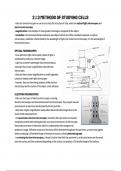2.1.3 Methods of studying cells
-there are two microscopes we can use to study the structure of cells, which are optical/light microscopes and
electron microscopes
-magnification is the number of times greater the image is compared to the object
-resolution is the minimum distance between two objects which can still be considered separate. In optical
microscopes, resolution is determined by the wavelength of light, but in electron microscopes, it is the wavelength of
the electron beams
Optical microscopes
-in an optical (or light microscope) a beam of light is
condensed to produce a coloured image.
-Light has a shorter wavelength than electron beams,
meaning it has a lower magnification than electron
microscopes.
-they also have a lower magnification so small organelles
cannot be viewed under light microscopes
-however, they can view living samples, unlike electron
microscopes and the colour of the object can be retained
Electron microscopes
-there are two types of electron microscopes, scanning
electron microscopes and transmission electron microscopes. They require vacuum
environments as electrons are absorbed by the air particles.
-they have a higher magnification and produce black and white images due to the
heavy metal staining process
-in transmission electron microscopes, extremely thin specimens are stained
using heavy metals before being placed in a vacuum environment. An electron gun
then produces a beam of electrons which is condensed by electromagnets to
produce an image. Different amounts of electrons will be absorbed throughout the specimen, so some areas appear
darker, producing a 2D detailed image of internal structures, called a photomicrograph.
-in scanning electron microscopes, it doesn't matter how thick the specimen is, as electron beams are focussed
onto the surface and then scattered depending on the contours to produce a 3D detailed image of the surface.




